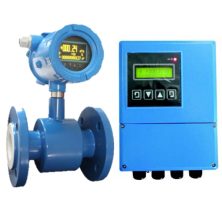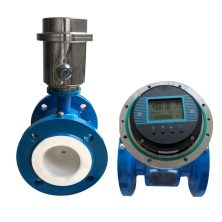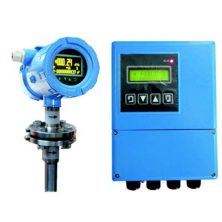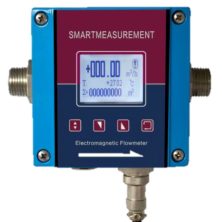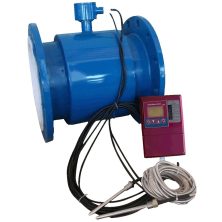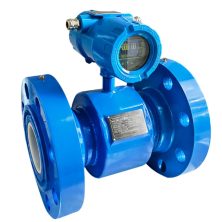Featured Products
- ½"-80" (15-2000mm)
- ±0.2% of reading
-
Liquids w/ electrical conductivity
≤ 5 μS/cm - -58-356°F (-50-180°C)
- Neoprene, PTFE, PFA, F46 Ceramic, Hard rubber
- SS #316L, Hastelloy C, Nickel, Titanium, Ceramic
- Wafer type & flanged - ANSI, DIN, JIS, & Sanitary
- Conductive fluids ≥ 5 μS/cm
- Water, Wastewater, Power, Chemical, Food/Beverage, Factory Automation
Features & Benefits
- General Purpose: Ideal for a wide range of fluid velocities and industrial applications.
- Versatile Use: Perfect for sectors like food and beverage, municipal/wastewater, pulp and paper, and industrial process control.
- Advanced Features: Includes an easy-to-read OLED display, various communication options, and a selection of liner materials.
- ½"-24" (15-600mm)
- ±1% of reading
-
Liquids w/ electrical conductivity
≤ 20 μS/cm - -40-300°F (-50-150°C)
- Neoprene, PTFE, PFA, F46 Ceramic, Hard rubber
- SS #316L, Hastelloy C, Nickel, Titanium, Ceramic
- Wafer type & flanged - ANSI, DIN, JIS, & Sanitary
- Conductive fluid measurement in areas with no power available
- Water, Wastewater, Power, Chemical, Food/Beverage, Factory Automation
Features & Benefits
- Remote Applications: Best suited for water applications in remote locations.
- Battery Operated: Equipped with a replaceable lithium battery with a lifetime of up to 5 years.
- Rugged Design: Features remote communication capabilities and a durable IP68 enclosure.
- ½"-240" (15-6000 mm)
- 1.5%
-
Liquids w/ electrical conductivity
≤ 5 μS/cm - -58-356°F (-50-180°C)
- N/A
- SS #316L, Hastelloy C, Nickel, Titanium, Tantalum
- Threaded, ball valve, flanged - ANSI, DIN, & JIS
- Large pipes where high accuracy is NOT needed
- Wastewater & municipal
Features & Benefits
- Flexible Installation: Designed for hot-tapped or permanent installations in large pipelines.
- Broad Applicability: Common in utility pipelines, irrigation systems, and limited-modification applications.
- User-Friendly: Offers various mounting options and easy maintenance.
ALMAGMINI
- Pipe Sizes: ⅛"-½" (3-15mm)
- ±0.5% of reading
-
Liquids w/ electrical conductivity ≤
20 μS/cm - -40-190°F(-40-90°C)
- Polyethylene, PEEK
- SS #316L, Hastelloy C
- Threaded (NPT, BSP)
-
Conductive fluids ≥ 20 μS/cm;
low flows, leak detection, chemical injection - Chemical dosing, food & beverage, leak detection
Features & Benefits
- Low Flow Precision: Tailored for accurate measurement of low-flow conductive liquids.
- Specialized Applications: Ideal for chemical injection, corrosive fluids, and batching applications.
- Integrated Features: Comes with a temperature sensor and an integrated display for easy monitoring.
ALMAGEG
- Pipe Sizes: ½"-24" (10-600mm)
- ±0.5% of reading
-
Liquids w/ electrical conductivity ≤
5 μS/cm - -58-356°F (-50-180°C)
- Neoprene, PTFE, PFA, F46 Ceramic, Hard rubber
- SS #316L, Hastelloy C, Nickel, Titanium, Ceramic
- Wafer type & flanged - ANSI, DIN, JIS, & Sanitary
- Hot water metering/sub-metering, chillers, heat exchangers
- Building automation, municipal
Features & Benefits
- Energy Measurement: Designed for thermal energy measurement in fluid systems.
- Versatile in Energy Systems: Suitable for chilled, hot, and condenser water systems.
- High Accuracy: Ensures precise energy management with a range of liner materials and sizes.
ALMAGHP
- 1"-6" (25-150mm)
- ±0.5% of reading
-
Liquids w/ electrical conductivity ≤
5 μS/cm - -58-356°F (-50-180°C)
- PFA
- SS #316L, Hastelloy C, Nickel, Titanium, Ceramic
- Flanged ANSI, DIN, JIS
- High pressure water injection, water-based hydraulic fluids
- Oil & gas, fluid power
Features & Benefits
- High-Pressure Capability: Handles extreme pressures, suitable for demanding industrial environments.
- Wide Size Range: Accommodates a variety of line sizes with different flange options.
- Robust Construction: Features a high turndown ratio and IP68 protection for challenging conditions.
Choosing The Right Mag Meter
Choosing the appropriate magnetic flow meter is crucial for ensuring accurate and reliable measurements. Several factors must be considered to select the best model for specific applications. This guide outlines key considerations and provides insights into making an informed decision.
Understanding Fluid Characteristics
- Conductivity: The primary requirement for a fluid to be measured with a magmeter is conductivity. Ensure the fluid’s conductivity meets the minimum threshold required by the magmeter, which is typically 3 to 5 μS/cm depending on the meter and manufacturer.
- Corrosiveness and Abrasiveness: Select a meter with materials compatible with the fluid’s properties. Corrosive fluids may require meters with special liner materials, while extremely abrasive fluids may require all-ceramic wetted parts in order to prevent wear.
- Temperature: High temperatures fluids can affect the meter’s operation. Remote mount electronics or special liner materials may be required in order to withstand the elevated operating temperatures. Choose a meter designed to withstand these conditions without compromising performance.
Considering the Installation Environment
- Pipeline Size and Configuration: The meter should fit the existing pipeline size and configuration. For large pipelines, insertion meters might be more practical, whereas inline meters are suitable for smaller pipes.
- Flow Profile: Like most other flow measurement technologies, turbulent flow profiles affect the mag meter’s performance. In order to ensure sufficiently laminar flow for the magmeter’s operation, inline meters typically require a minimum 5 pipe diameters of straight, rigid pipe immediately upstream of the meter and 3 diameters downstream. Insertion style mag meters typically require 10 diameters upstream and 5 downstream.
- Accessibility and Maintenance: Consider ease of installation and maintenance. Remote areas with no power locations might benefit from battery-powered mag meters. In situations where it is difficult to shut down the process, cut the pipeline, and weld on flanges, insertion meters may be the ideal choice.
Application-Specific Requirements
- Industry Standards: Certain industries have specific standards, especially concerning hygiene. Sanitary meters are essential for food and beverage or pharmaceutical applications.
- Regulatory Compliance: Ensure the meter meets any regulatory requirements, such as environmental standards or safety certifications.
- Data Integration and Output: For automated processes or smart systems, choose meters with advanced communication capabilities and compatible data outputs.
Evaluating Additional Features
- Diagnostic Functions: Advanced meters offer diagnostic features that can alert users to issues like electrode coating and empty/partially filled pipelines.
- Power Options: Consider whether a meter needs to be powered by the mains, or if a battery-powered option is more suitable.
- Budget Constraints: Balance the need for specific features against budget limitations. While more advanced meters offer greater capabilities, basic models might suffice for simpler applications.
Selecting the right magnetic flow meter involves a careful assessment of fluid properties, installation environment, industry-specific requirements, and additional features. By considering these factors, you can choose a model that not only fits your immediate needs but also offers long-term reliability and efficiency.
The Core Principle: Electromagnetic Induction
Magmeters function utilizing the principles of Faraday’s Law of Electromagnetic Induction. This law explains that when a conductive fluid passes through a magnetic field, it generates a voltage. The strength of this voltage is directly related to the rate at which the fluid is flowing, thereby offering a precise measurement of its velocity.
SmartMeasurement Magnetic Flow Meters
SmartMeasurement offers a diverse range of magnetic flow meters, each designed to meet specific industrial requirements. Here’s an overview of our featured products, showcasing their unique capabilities and applications:
Inline-Type Magnetic Flow Meter (ALMAG WP)
- General Purpose: Ideal for a wide range of fluid velocities and industrial applications.
- Versatile Use: Perfect for sectors like food and beverage, municipal/wastewater, pulp and paper, and industrial process control.
- Advanced Features: Includes an easy-to-read OLED display, various communication options, and a selection of liner materials.
Battery Powered Magnetic Flow Meter (ALMAG BAT)
- Remote Applications: Best suited for water applications in remote locations.
- Battery Operated: Equipped with a replaceable lithium battery with a lifetime of up to 5 years.
- Rugged Design: Features remote communication capabilities and a durable IP68 enclosure.
Insertion Magnetic Flow Meter (ALMAG IS)
- Flexible Installation: Designed for hot-tapped or permanent installations in large pipelines.
- Broad Applicability: Common in utility pipelines, irrigation systems, and limited-modification applications.
- User-Friendly: Offers various mounting options and easy maintenance.
Small Size Low Flow Magnetic Flow Meter (ALMAG MN)
- Low Flow Precision: Tailored for accurate measurement of low-flow conductive liquids.
- Specialized Applications: Ideal for chemical injection, corrosive fluids, and batching applications.
- Integrated Features: Comes with a temperature sensor and an integrated display for easy monitoring.
Energy/BTU Magnetic Flow Meter (ALMAG EG)
- Energy Measurement: Designed for thermal energy measurement in fluid systems.
- Versatile in Energy Systems: Suitable for chilled, hot, and condenser water systems.
- High Accuracy: Ensures precise energy management with a range of liner materials and sizes.
High Pressure Magnetic Flow Meter (ALMAG HP)
- High-Pressure Capability: Handles extreme pressures, suitable for demanding industrial environments.
- Wide Size Range: Accommodates a variety of line sizes with different flange options.
- Robust Construction: Features a high turndown ratio and IP68 protection for challenging conditions.
Each of these magnetic flow meters is engineered to provide precise and reliable measurements, catering to specific needs across various industries. From general-purpose applications to specialized high-pressure environments, SmartMeasurement’s range of magmeters ensures optimal performance and durability.
Key Advantages
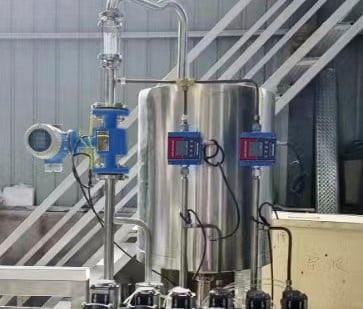
Magmeters excel in scenarios requiring conductive measurement methods. This characteristic is crucial for fluids that are dirty, corrosive, or abrasive and for applications where minimizing the pressure loss across the meter is critical. By employing a non-mechanical measurement technique, magmeters ensure both measurement accuracy and a long service life. The lack of moving parts in the magmeters’ design & construction makes them particularly suitable for applications seen in the food and beverage industry where maintaining hygiene and cleanliness is crucial, and also provides for reduced maintenance and improved longevity versus older technology flowmeters such as turbine and positive displacement type.
Designed for Diverse Industrial Applications
The design of magmeters, devoid of any moving parts, significantly lowers the need for maintenance while enhancing their durability. This aspect makes them an economical option across numerous industries. Furthermore, their robust build ensures reliable functionality in challenging settings, such as chemical processing plants and outdoor agricultural areas. Explore how our magnetic flow meters serve various industries.
Advantages of Magnetic Flow Meters Over Other Flow Measurement Technologies
Magnetic flow meters (magmeters) offer several distinct advantages over other flow measurement technologies, such as turbine, positive displacement, and even ultrasonic flow meters in specific scenarios. Here’s a comparative analysis that emphasizes the correct information about magmeters:
Non-Mechanical Measurement Principle
- Magmeters: Utilize Faraday’s Law of Electromagnetic Induction, measuring flow based on the voltage induced across a conductive fluid moving through a magnetic field. This method does not involve moving parts within the flow, reducing wear and maintenance.
- Other Technologies: Mechanical meters like turbine and positive displacement meters rely on the physical movement of components to measure flow, which can wear out over time and require more frequent maintenance.
Minimal Flow Obstruction and Pressure Drop
- Magmeters: Although intrusive, they are designed to minimize flow obstruction and pressure drop across the meter. The flow tube is typically smooth and matches the diameter of the pipeline, maintaining efficient fluid movement.
- Other Technologies: Some mechanical meters introduce significant obstruction to the flow, leading to a pressure drop. This can affect process efficiency and increase energy costs in pumping systems.
Broad Fluid Compatibility
- Magmeters: Can measure almost any conductive liquid, including corrosive, viscous, and slurry fluids, without concern for clogging or damage to the meter. Non-conductive fluids can’t be measured by magmeters.
- Ultrasonic Flow Meters: Non-intrusive and versatile, capable of measuring both conductive and non-conductive fluids. However, they may struggle with high particulate or gaseous content fluids unless specifically designed for such conditions.
- Other Technologies: May have limitations with corrosive or highly viscous fluids. For instance, mechanical parts in turbine meters can erode or jam when used with abrasive slurries.
Accurate and Reliable Measurement
- Magmeters: Offer high accuracy and repeatability, unaffected by fluid density, viscosity, temperature, and pressure changes, making them suitable for critical applications where precise flow measurement is essential.
- Other Technologies: The accuracy of mechanical meters can be influenced by changes in fluid properties or wear and tear over time. Ultrasonic meters’ accuracy might be affected by the acoustic properties of the fluid and in most cases the presence of air bubbles or suspended solids, with the exception of SmartMeasurement’s ALSONIC DSP.
Low Maintenance Requirements
- Magmeters: With no moving parts and robust construction, magmeters typically require less maintenance than mechanical meters, contributing to a lower total cost of ownership.
- Other Technologies: Mechanical meters may require regular maintenance to ensure accuracy, including cleaning, calibration, and part replacement. Ultrasonic meters, while also low in maintenance, may need occasional checks to ensure the correct alignment and cleanliness of the external sensors.
Versatility and Integration
- Magmeters: Can be integrated into a wide range of industrial processes thanks to their ability to handle various fluid types and conditions. They often feature digital outputs for easy integration with control systems.
- Other Technologies: While versatile, each technology has its niche based on the specific fluid characteristics and application requirements. Ultrasonic meters, for instance, offer flexibility for temporary measurements or retrofitting existing systems without process interruption.
In summary, magnetic flow meters present a compelling option for many industrial applications, especially when measuring the flow of conductive liquids. Their principle of operation, coupled with the design advantages, positions them as a reliable, accurate, and cost-effective solution compared to other flow measurement technologies.
Magnetic Flowmeter Applications
Magnetic flow meters, known for their accuracy and versatility, are extensively used across a variety of industries. Their ability to accurately measure the flow of conductive liquids makes them indispensable in numerous applications. Here are some real-world examples and case studies that demonstrate the effectiveness and efficiency of magnetic flow meters:
Water and Wastewater Management
- Municipal Water Treatment: In municipal water treatment facilities, magnetic flow meters are crucial for measuring the flow of water through treatment processes, ensuring accurate dosing and efficient operation.
- Wastewater Treatment Plants: Magmeters are extensively used in wastewater treatment for monitoring and controlling the flow of effluent. Their accuracy is vital for managing treatment processes and ensuring regulatory compliance.
Food and Beverage Industry
- Beverage Production: In the beverage industry, magnetic flow meters are used to measure the flow of various liquids, including water, juices, and other ingredients, ensuring precise blending and consistency in product quality.
- Dairy Processing: Magmeters play a key role in dairy processing plants, where they measure the flow of milk and other dairy products, maintaining hygiene and accuracy in production.
Chemical and Pharmaceutical Industries
- Chemical Dosing: Magnetic flow meters are used for precise chemical dosing in various industrial processes, ensuring the correct chemical mix and reaction in manufacturing.
- Pharmaceutical Production: In pharmaceutical manufacturing, magmeters are employed to measure the flow of various fluids, maintaining strict control over the production process to ensure the quality and safety of pharmaceutical products.
Pulp and Paper Industry
- Pulp Processing: In pulp processing, magnetic flow meters are used to measure the flow of pulp and water mixtures, crucial for controlling the consistency and quality of the paper produced.
- Chemical Additives Measurement: Magmeters are also used to measure the flow of chemical additives in the paper-making process, ensuring the right composition for different types of paper.
Mining and Mineral Processing
- Slurry Flow Measurement: In mining operations, magnetic flow meters are used to measure the flow of mineral slurry, providing accurate data for processing and refining operations.
- Water Management: They are also used in water management within mining operations, measuring the flow of water used in various processes and for environmental control.
These case studies highlight the diverse and critical applications of magnetic flow meters in different sectors. From ensuring product quality in the food and beverage industry to managing complex processes in water treatment and mining, magnetic flow meters provide reliable and accurate measurements, contributing significantly to the efficiency and effectiveness of industrial operations.
Installation and Maintenance
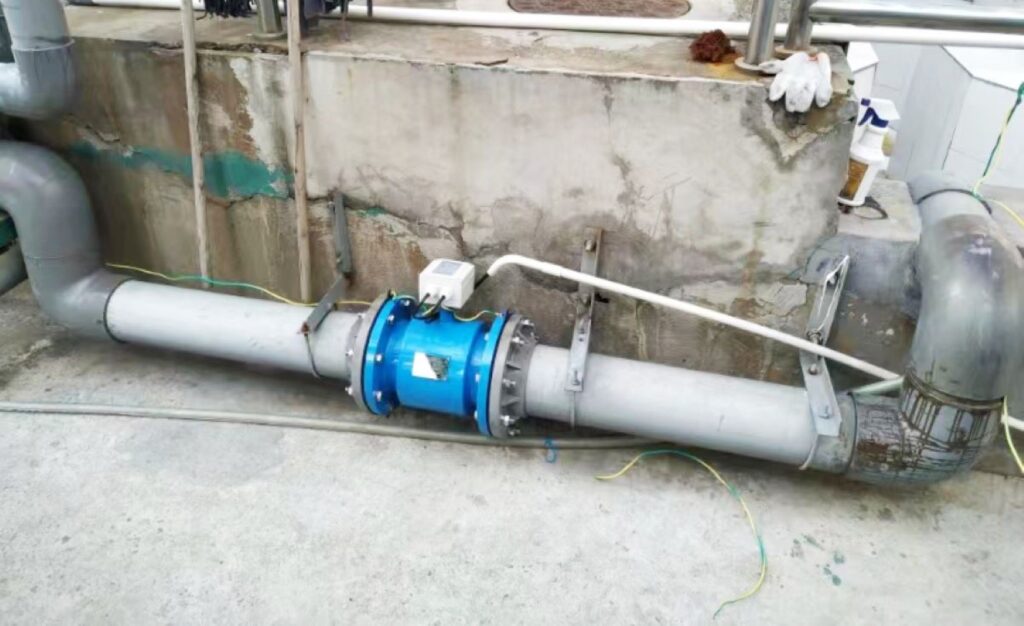
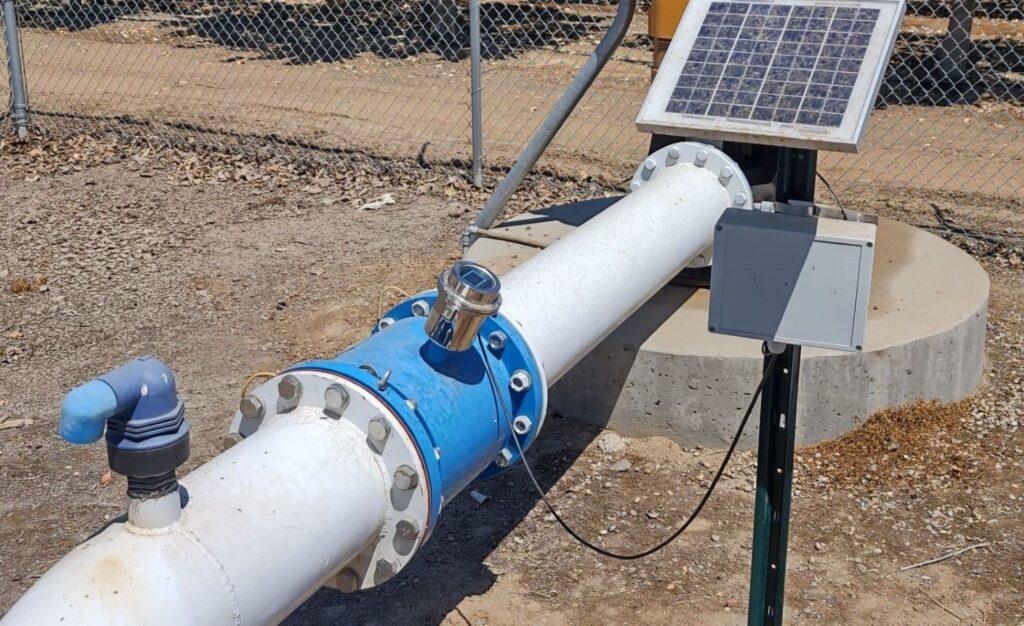
Proper installation and maintenance are crucial for the optimal performance and longevity of magnetic flow meters. This section offers a detailed guide on installation procedures, crucial maintenance advice, and solutions to frequently encountered troubleshooting situations.
Step-by-Step Installation Overview
- Site Selection: Choose a location where the meter can be easily accessed for maintenance. Ensure the pipe is fully filled with fluid during operation.
- Preparing the Pipeline: Before installation, flush the pipeline to remove any debris. The pipe’s interior should be clean and free of any lining protrusions or weld seams.
- Meter Orientation: Install the meter in the orientation specified by the manufacturer. Horizontal installation is preferred, but vertical installation is also common.
- Electrical Connections: Connect the meter to a power source and any necessary control systems following the manufacturer’s wiring diagrams and local electric codes.
Maintenance Tips for Longevity and Accuracy
- Regular Inspections: Periodically inspect the meter for any signs of wear or damage, especially the electrodes and lining.
- Cleaning: Keep the electrodes and the flow tube clean. Some meters have self-cleaning electrodes, but manual cleaning may be required in certain environments.
- Calibration Checks: Regularly check the calibration and recalibrate if necessary to ensure accurate measurements.
- Firmware Updates: Keep the meter’s firmware updated to ensure you have the latest features and improvements.
Troubleshooting Common Issues
- No Flow Reading: Ensure the flowmeter is powered and the flow tube is full of fluid. Check for electrical connection issues.
- Inaccurate Readings: Verify the meter’s calibration. Inspect for any lining degradation or electrode fouling that might affect accuracy.
- Erratic Readings: Double check the meter’s electrical grounding. Verify that the meter’s straight pipe run requirements have been met. Ensure the installation site is free from external magnetic or electrical interference.
By following these installation and maintenance guidelines, you can ensure that your magnetic flow meters operate efficiently and provide accurate measurements over their lifespan. Regular maintenance and prompt troubleshooting can significantly extend the service life of these devices and ensure consistent performance in various industrial settings.
Advanced Features and Innovations
Magnetic flow meter technology has seen significant advancements in recent years, driven by the need for more accurate, reliable, and versatile flow measurement solutions. These innovations not only enhance the functionality of magmeters but also pave the way for future trends in this field.
Recent Technological Advancements
- Digital Signal Processing (DSP): Modern magmeters incorporate DSP for enhanced signal processing. This leads to improved accuracy and noise filtration, allowing for precise measurements even in challenging fluid conditions.
- Smart Diagnostics: Advanced diagnostic features enable early detection of potential issues, such as electrode coating, ensuring timely maintenance and uninterrupted operation.
- Wireless Communication: Integration of wireless technology allows for remote monitoring and data access, facilitating easier management of flow meters in hard-to-reach or hazardous locations.
- Enhanced Liner Materials: Development of new liner materials has expanded the range of fluids that can be measured, including highly corrosive or abrasive liquids, broadening the applicability of magmeters in various industries.
Future Trends in Magnetic Flow Meter Technology
- Internet of Things (IoT) Integration: The future of magmeters lies in their integration with IoT platforms, enabling real-time data analysis, predictive maintenance, and seamless integration with other industrial systems for comprehensive process control.
- Miniaturization: There is a growing trend towards smaller, more compact magmeter designs, allowing for easier installation and use in space-constrained environments.
- Energy-Efficient Designs: As sustainability becomes a priority, the development of energy-efficient magmeters that require minimal power to operate is likely to gain traction.
- Advanced Meter Verification: Future magmeters may feature sophisticated self-verification technologies, allowing users to verify calibration and meter performance in situ without interrupting the process flow.
- Multiparameter Sensing: Emerging technologies may enable magmeters to measure additional parameters like temperature or density, providing more comprehensive insights into the fluid characteristics.
These advancements and future trends reflect the ongoing evolution of magnetic flow meter technology. As industries continue to demand more sophisticated and efficient flow measurement solutions, magmeters are poised to incorporate even more innovative features, ensuring their relevance and utility in a wide range of applications.
Theories of Operation
How Magnetic Flow Meters Work: A Deeper Dive
Magnetic flow meters are integral to modern flow measurement, operating on principles grounded in physics. Their functionality hinges on Faraday’s Law of Electromagnetic Induction and involves several key components, each playing a vital role in ensuring accurate and reliable measurements.
The Operating Principle: Faraday’s Law
Faraday’s Law is central to a magmeter’s operation. It states that the movement of a conductive fluid through a magnetic field induces a voltage. This voltage, proportional to the fluid’s velocity, is the basis for measuring flow rate. The relationship between fluid velocity and voltage generation is crucial for accurate flow measurements. This principle allows magmeters to provide consistent and reliable readings, even in applications with rapid flow rate changes or varying fluid properties.
Key Components of Magnetic Flow Meters
- Electromagnetic Coils: These coils, surrounding the flow tube, generate a magnetic field perpendicular to the fluid flow. The strength and stability of this magnetic field are key to the accuracy of the flow measurement.
- Electrodes: Positioned opposite each other on the flow tube, they detect the voltage induced by the fluid’s movement through the magnetic field. These electrodes are designed to be sensitive to even minor changes in voltage, ensuring precise flow rate detection.
- Flow Tube: Typically made from non-ferrous materials, it serves as the conduit that the measured fluid flows through. The material that the flow tube is lined with is chosen to be compatible with the fluid being measured, preventing any chemical reaction or contamination.
- Transmitter: This unit processes the voltage signal from the electrodes, calculates the flow rate, and converts it into a readable output. Advanced transmitters also offer additional functionalities like data logging, communication with control systems, and diagnostic capabilities.
Magnetic flow meters rely on Faraday’s law of electromagnetic induction which states that an inductive voltage is generated when a conductor moves through a magnetic field. Inside of the mag meter’s flow tube, when a conductible fluid passes through the magnetic field generated by the meter’s electromagnetic coils at a right angle to the field, the voltage induced at the electrode is directly proportional to the density of the magnetic field, the distance between the sense electrodes, and the velocity of the fluid. Therefore, the voltage measured across the meter’s electrode, measured in mV, is directly proportional to the fluid velocity of the measured media. Since the area inside of the flow tube is a known quantity, the measured velocity can then very easily be used to accurately calculate the volumetric flow rate through the meter. The magnetic flow meter is a type of volumetric flow meter that measures the velocity of fluids in a tube or pipe by utilizing electrodes connected to the liquid velocity.

Magnetic flow meters come with many liners such as Neoprene, natural rubber, PTFE, PFA, PU (polyurethane), F46, ceramic and many more to protect it from corrosive and/or abrasive liquids. Sensor materials must also consider the fluids corrosive and/or abrasive therefore it comes in 316SS, Hastelloy, Nickle, Titanium, Tantalum, etc.

Fleming’s Left-Hand Rule and Fleming’s Right-Hand Rule are essential rules applicable in magnetism and electromagnetism. John Ambrose Fleming developed them in the late 19th century as a simple way of working out the direction of electric current in an electric generator or the direction of motion in an electric motor.

.
